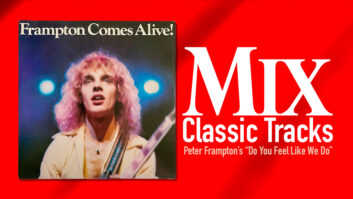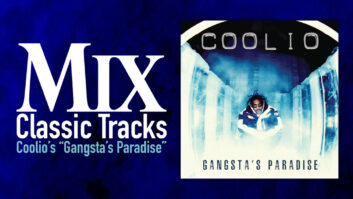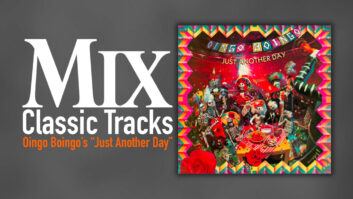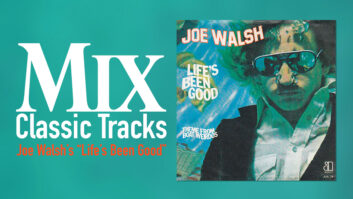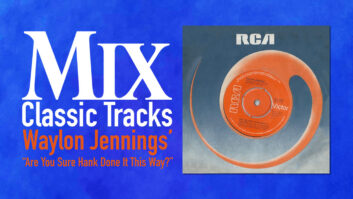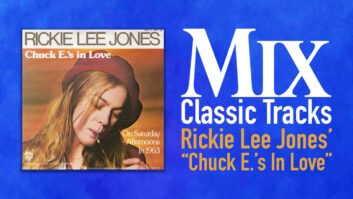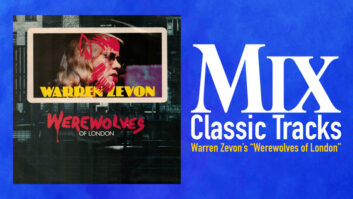As this issue of Mix has a focus on live recording, we thought it would be appropriate to finally tackle a track from the best-selling live rock album of all time, Frampton Comes Alive, by British rocker Peter Frampton. With sales now topping 16 million worldwide (it had sold about 13 million within two years of its release), it remains an unparalleled phenomenon. It helped spur the growth of the remote recording industry through the late ’70s, and, of course, it made Frampton one of the biggest stars in the world, albeit briefly.
Read more “Classic Tracks”
Buy the book
“Peter was the Golden Boy,” offers engineer Eddie Kramer, who engineered this month’s “Classic Tracks” in the Fedco Audio Labs remote truck at the Island Music Center in Commack Long Island, N.Y., in August 1975. “It seemed to be destiny or something that Peter would become a superstar. He was this really nice person and obviously very talented. He could sing, he played great guitar and he had a bunch of good songs. It was only a matter of time before he was ‘discovered’ [by the mass public].”
Talk about having the itch to play rock ‘n’ roll: The Beckenham, England, native started playing guitar in local bands as a pre-teen (even sharing a bill once with classmate David Jones, the future Bowie). By 16, he had joined a Mod-ish band called The Herd, who enjoyed some success with the teenybopper crowd around England in the late ’60s. In 1969, at the age of 19, he joined screecher Steve Marriott, late of the Small Faces, and formed the hard-rocking quartet Humble Pie. They were another group that managed to attract a large following around England, but their first two albums failed to gain much notice in the U.S. However, their fourth album, Performance: Rockin’ the Fillmore (1971), proved to be an enormous FM radio hit in the U.S., thanks to raucous tunes such as their version of “I Don’t Need No Doctor.” That album was recorded and mixed by Kramer, the British engineer already famous for his studio work with Jimi Hendrix, Led Zeppelin, Traffic and so many other bands, then a fairly recent transplant in New York.
Frampton, an incendiary axe-slinger who also provided most of Humble Pie’s softer, more lyrical moments, left the band around the time that live album was hitting big, and by 1972, had signed with A&M Records and cut his first solo album, Wind of Change, with the help of Billy Preston and Ringo Starr, among others. Frampton’s pleasing formula of mixing melodic acoustic elements with slamming electric guitars in the studio probably owed something to Led Zeppelin, but his inclinations were even more mainstream and commercial, even if it took awhile for his sound to take off with record buyers. The following year, he formed a group called Frampton’s Camel, recorded an album under that name — engineered by Kramer at Electric Lady in New York — and started what would become a succession of tours across the U.S., which — slowly, but surely — built a strong following for the handsome and charismatic performer. That album was followed in relatively quick succession by Something’s Happening (1974) and Frampton (1975). The studio version of “Show Me the Way” originally appeared on the latter album, and it was the recordings of the U.S. tour supporting that record that became the source of Frampton Comes Alive.
Actually, at this point in the process, Kramer was not involved with the live recording. The initial tracks for Frampton Comes Alive — and the bulk of those eventually used for the album — were recorded by Ray Thompson at San Francisco’s 5,000-seat Winterland Arena and the much smaller Marin Veteran’s Auditorium in nearby San Rafael, Calif., in June ’75 using the Wally Heider mobile recording truck. (Thompson had previously cut successful live albums with the likes of Aretha Franklin, Steppenwolf, King Curtis, Johnnie Taylor and others.) The story goes that Frampton played some of the tapes from those shows for A&M Records honcho Jerry Moss — including the nearly 14-minute tour de force “Do You Feel Like We Do” — and Moss was so excited that he was convinced that Frampton’s live album should be two discs instead of one. So when the tour hit the East Coast in August, Moss had several new dates recorded, this time by Kramer in the Fedco truck, which operated out of Providence, R.I., and was widely renowned for past live album projects, including The Doors’ Absolutely Live and Kramer’s recordings of Humble Pie and Curtis Mayfield.
“The Fedco truck wasn’t much compared to what’s out there today, of course,” Kramer muses. “If I’m not mistaken, it had been a bread van at one point. It had a very good-sounding custom console of some sort and Stephens [16-track] machines, which were also pretty good when they were working well. That was a nice little truck; we got some good things out of it.”
“Show Me the Way” was one of three songs on Frampton Comes Alive that was recorded at the cavernous Island Music Center, the one-time home of the Long Island Ducks minor-league hockey team and a popular mid-sized hall for rock acts when it was known as the Long Island Arena. (I saw Hot Tuna play there in 1971 and can testify to the hall’s abysmal, airplane hangar — like acoustics.) In a quote on Frampton’s Website (www.frampton.com), he relates that “Show Me the Way” came from an incredibly prolific period right before the recording of Frampton: “The whole album only took three weeks to write and gave us ‘Show Me the Way,’ which was written one day before lunch, and ‘Baby, I Love Your Way,’ which was written the same day, after tea, as the sun was setting.” The studio version of “Show Me the Way” was released as a single during 1975, but failed to catch fire.
Kramer says that he would generally use whatever mics a band was carrying for his live recordings, “but I would also make a few swaps. I’d talk to the P.A. guys and maybe get some [Neumann] 67s in there as overheads, for instance.” Whereas in his early days of live recording when he would often use a split from the snake before it hit the P.A., Kramer suspects that by the time of the Frampton recordings, “We went into splitter boxes first and then I would take my feed and [the front of house] would take theirs, but we would kind of jointly figure out if they could tolerate using some better mics and, generally speaking, they did.” Frampton’s group was just a four-piece — John Siomos played drums, Bob Mayo on keyboards and other guitars, and Stanley Sheldon on bass — but that was still plenty to quickly max out the inputs, considering there were also audience mics to hang.
Though his memory is hazy on the details of the recording that occurred more than 30 years ago, Kramer suggests that Frampton likely sang through a Shure SM58 and there was probably an SM57 on his guitar amplifier. Frampton famously played a black Gibson Les Paul with three pickups, and on “Show Me the Way” (and “Do You Feel Like We Do”), he employed a Heil Sound Talkbox as a primary effect. The way that box worked is, the speaker output from the guitar amp was routed through the box, up a long, thin plastic tube mounted on Frampton’s mic stand. He would put his mouth over the tube and then “sing” the note he was playing on the guitar — the two elements combining in his vocal mic, giving a weird electronic character to a note or word as it shot back through to a miked amp. Frampton wasn’t the first rock performer to use a Talkbox — Black Sabbath, Joe Walsh, Iron Butterfly and others preceded him — but he certainly popularized it; it became part of his signature sound, and today, Frampton sells his own version as part of his Framptone line of guitar accessories.
As for the audience mics, “I usually had a pair looking out into the audience from the stage, and if I were lucky enough and we got there early enough, I got the guys to sling mics above left and right in the rear [of the hall] to capture the audience; alternatively, if I couldn’t do that, I’d put a pair facing edgewise off of the front-of-house desk, facing left and right or rear, or sometimes even facing front. My favorite audience mics were [Neumann] 87s, but I know I also would use [AKG] 414s.”
Chris Kimsey did the bulk of the album’s mixing at Electric Lady Studios in New York City, but Frampton himself mixed “Show Me the Way” when Kimsey had to leave to work on another project. The album was mastered at the Mastering Lab in L.A. by Mike Reese.
Frampton Comes Alive charted immediately after it was released in January 1976, and by February, the single of “Show Me the Way” was skittering up the charts, eventually landing at Number 6. The album itself would hit Number One and stay there for 10 weeks; its success also catapulted the Frampton album to Gold status. If you were anywhere near a radio in 1976, Frampton was inescapable. And it wasn’t just a couple of songs getting airplay; FM radio went deep into that album, and why not: It was strong from beginning to end, and it seemed to put a smile on everyone’s face.
After the massive and unpredictable success of Frampton Comes Alive, the newly minted superstar capitalized on his fame by playing arena and stadium shows around the U.S., and his next studio album, I’m In You, yielded Frampton’s biggest hit single ever (the title track, which reached Number 2) and sold millions, but not enough millions, apparently. The album was widely viewed as a commercial disappointment, and that was followed by two more traumatic career blows: first, his appearance as Billy Shears in the widely (and rightly) despised film Sgt. Pepper’s Lonely Hearts Club Band and then a serious automobile accident that put him out of commission for several months. Frampton never regained the momentum that seemed all but unstoppable during 1976 and 1977, but to his credit, he has managed to carve out a dignified and reasonably successful career in the years since. No longer the Golden Boy, he still has some serious chops, and everywhere he goes, he’s still revered for making some of the finest commercial rock of the 1970s.
